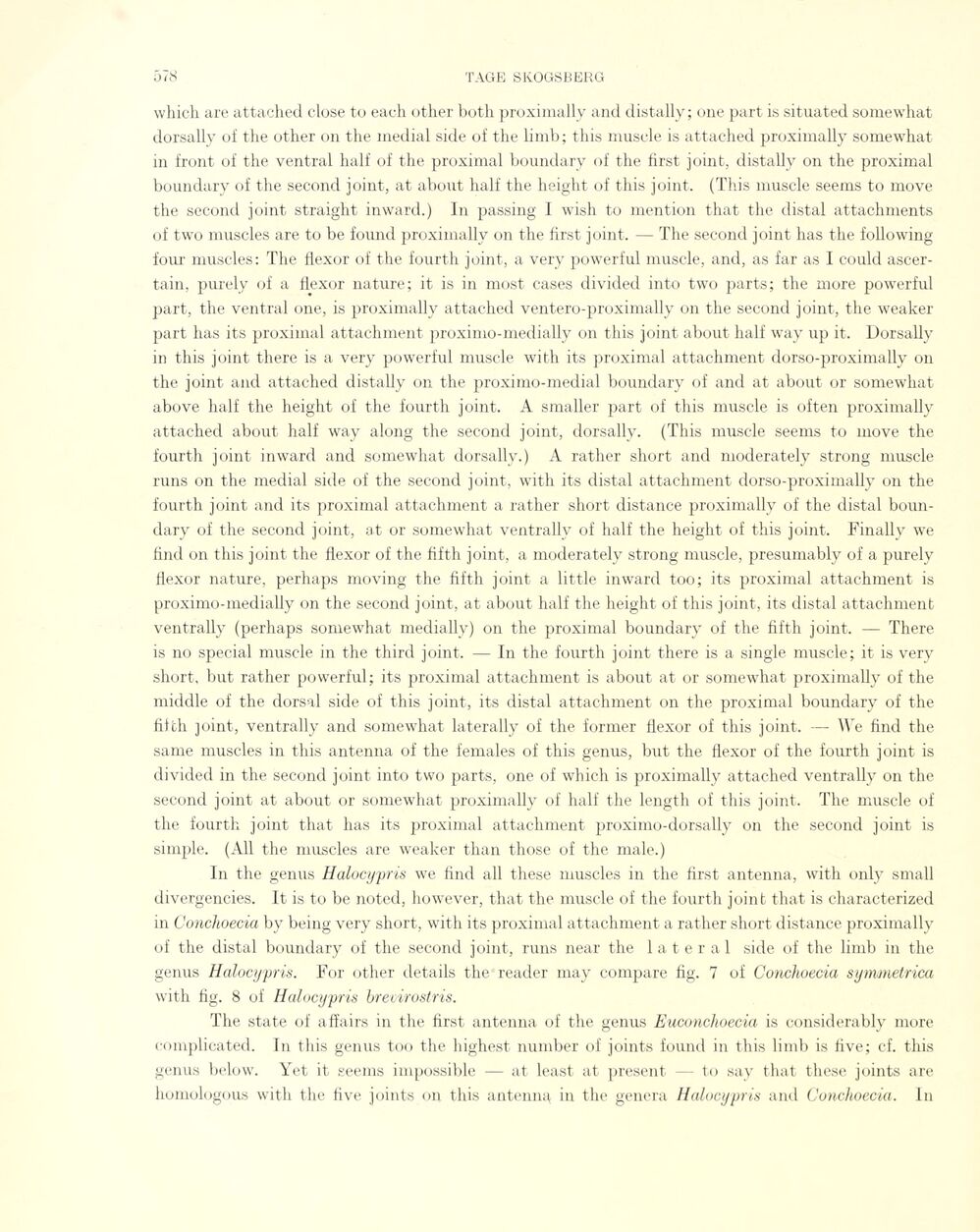
Full resolution (JPEG) - On this page / på denna sida - Sidor ...

<< prev. page << föreg. sida << >> nästa sida >> next page >>
Below is the raw OCR text
from the above scanned image.
Do you see an error? Proofread the page now!
Här nedan syns maskintolkade texten från faksimilbilden ovan.
Ser du något fel? Korrekturläs sidan nu!
This page has never been proofread. / Denna sida har aldrig korrekturlästs.
which are attachée! close to eaeh other both proximally and distally; one part is situated somewhat
dorsally ol the other on the medial side of the limb; this muscle is attached proximally somewhat
in front of the ventral half of the proximal boundary of the first joint, distally on the proximal
boundary of the second joint, at about half the height of this joint. (This muscle seems to move
the second joint straight inward.) In passing I wish to mention that the distal attachments
of two muscles are to be found proximally on the first joint. — The second joint bas the following
four muscles: The flexor of the fourth joint, a very powerful muscle, and, as far as I could
ascer-tain, purely of a flexor nature; it is in most cases divided into two parts; the more powerful
part, the ventral one, is proximally attached ventero-proximally on the second joint, the weaker
part lias its proximal attachment proximo-medially on this joint about half way up it. Dorsally
in this joint there is a very powerful muscle with its proximal attachment dorso-proximally on
the joint and attached distally on the proximo-medial boundary of and at about or somewhat
above half the height of the fourth joint. A smaller part of this muscle is often proximally
attached about half way along the second joint, dorsally. (This muscle seems to move the
fourth joint inward and somewhat dorsally.) A rather short and moderately strong muscle
runs on the medial side of the second joint, with its distal attachment dorso-proximally on the
fourth joint and its proximal attachment a rather short distance proximally of the distal
boundary of the second joint, at or somewhat ventrally of half the height of this joint. Finally we
find on this joint the flexor of the fifth joint, a moderately strong muscle, presumably of a purely
flexor nature, perhaps moving the fifth joint a little inward too; its proximal attachment is
proximo-medially on the second joint, at about half the height of this joint, its distal attachment
ventrally (perhaps somewhat medially) on the proximal boundary of the fifth joint. — There
is no special muscle in the third joint. — In the fourth joint there is a single muscle; it is very
short, but rather powerful; its proximal attachment is about at or somewhat proximally of the
middle of the dorsal side of this joint, its distal attachment on the proximal boundary of the
fifth joint, ventrally and somewhat laterally of the former flexor of this joint. — We find the
same muscles in this antenna of the females of this genus, but the flexor of the fourth joint is
divided in the second joint into two parts, one of which is proximally attached ventrally on the
second joint at about or somewhat proximally of half the length of this joint. The muscle of
the fourth joint that lias its proximal attachment proximo-dorsally on the second joint is
simple. (Ail the muscles are weaker than those of the male.)
In the genus Halocypris we find all these muscles in the first antenna, with only small
divergencies. It is to be noted, however, that the muscle of the fourth joint that is characterized
in Conchoecia by being very short, with its proximal attachment a rather short distance proximally
of the distal boundary of the second joint, runs near the lateral side of the limb in the
genus Halocypris. For other details the reader may compare fig. 7 of Conchoecia symmetrica
with fig. 8 of Halocypris brevirostris.
The state of affaire in the first antenna of the genus Euconchoecia is considerably more
complicated. In this genus too the highest number of joints found in this limb is five; cf. this
genus below. Yet it seems impossible — at least at present — to say that these joints are
homologous with the five joints on this antenna- in the genera Halocypris and Conchoecia. In
<< prev. page << föreg. sida << >> nästa sida >> next page >>